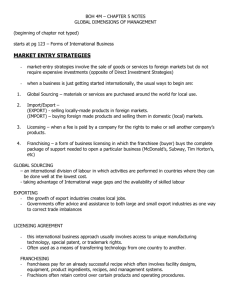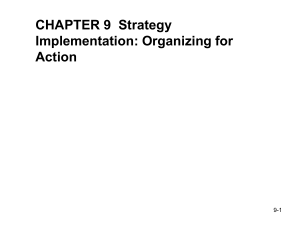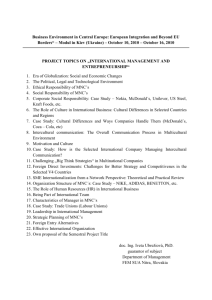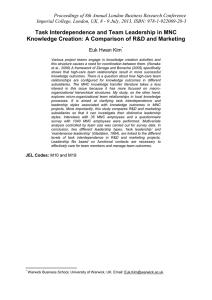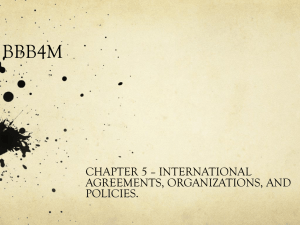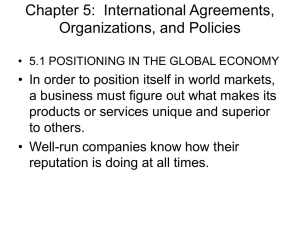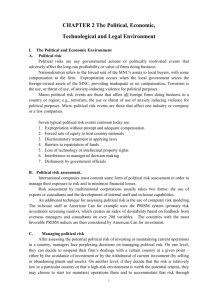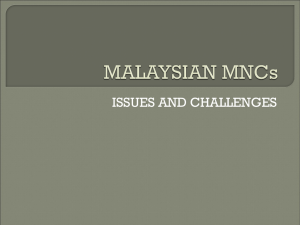Chapter 4
advertisement
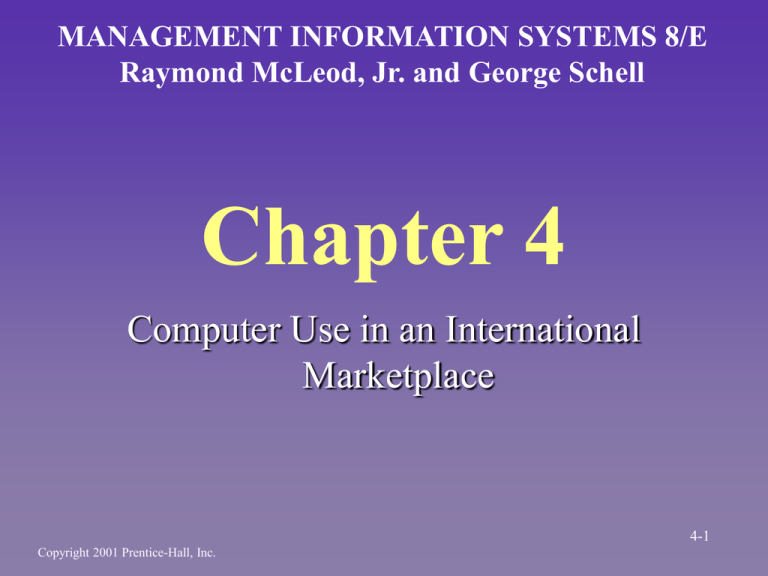
MANAGEMENT INFORMATION SYSTEMS 8/E Raymond McLeod, Jr. and George Schell Chapter 4 Computer Use in an International Marketplace 4-1 Copyright 2001 Prentice-Hall, Inc. The Multinational Corporation (MNC) Parent company and group of subsidiaries Operates across – Products – Markets – Nations – Cultures 4-2 Each Subsidiary Has Its Own Geography Goals Policies Procedures 4-3 Special Need for Information Processing in an MNC Influenced by internal and external conditions Seeks to minimize environmental uncertainty – Uncertainty - Difference between information required and information possessed Requires ‘good’ use of information technology to achieve desired performance 4-4 Types of MNC Organizational Structure Classifications Each structure requires its own information processor Worldwide functional divisions – Organized along functional lines – Marketing in subsidiary reports to marketing in parent company – Strategic planning done at top executive level – Data that integrates operations does not exist at lower levels 4-5 MNC Classifications (cont.) International regions – International division separate from domestic division Geographic regions – Each region responsible for its subsidiaries – No communication between regions – Communication coordinated by parent company 4-6 MNC Classifications (cont.) Worldwide product divisions – Product division responsible for operations worldwide – Helps recognize product specific needs 4-7 Need for Coordination in an MNC Greater need than domestic companies Companies unable to gain strategic control of their worldwide operations and manage them in a globally coordinated manner will not succeed in the emerging international economy Resources are widely distributed 4-8 Need for Coordination in an MNC (cont.) Improvements in information technology and methodology have made global coordination somewhat easier Still, coordination is big challenge 4-9 Advantages of Coordination in an MNC Flexibility in responding to competitors Ability to respond in one country to a change in another Ability to keep abreast of market needs around the world Ability to transfer knowledge between units in different countries 4-10 Advantages of Coordination in an MNC (cont.) Reduced overall costs of operation Increased efficiency and effectiveness in meeting customer needs Ability to achieve and maintain diversity in firm’s products, their production, and distribution 4-11 Global Business Strategies Multinational strategy Global strategy International strategy Transnational strategy All use global information systems (GISs) in various ways 4-12 Multinational Strategy Loose controls; strategic decisions remote HQ Financial reporting flows 4-13 Global Strategy Tight controls; centrally driven strategy HQ One-way flows, goods, information, and resources 4-14 International Strategy Assets, responsibilities decentralized Formal control systems International mentality HQ 4-15 Transnational Strategy Complex controls; high coordination skills,coordinated strategic decision process Heavy flows; materials, people information, technology HQ Distributed capabilities, resources and decision making 4-16 Global Business Drivers (GBD) Joint resources Flexible operations Rationalized operations Risk reduction Global products Scarce supplies Corporate customers 4-17 GBDs Cautions All GBDs do not apply to all MCNs Drivers have many influences – – – – Industry Country Own characteristics Business units within firm Provide vehicle for mapping out SPIR 4-18 Global Information Systems (GISs) Implementation Problems Politically imposed constraints – Hardware purchases and imports – Data processing – Data communications » Transborder data flows (TDF) Operational data Personal data Electronic funds transfer Technical and scientific data 4-19 Global Information Systems (GISs) Implementation Problems (cont.) Technological problems – Unreliable power – Slow telecommunications – Software copyrights and blackmarket products Lack of support from subsidiary managers – View corporate office as an ‘outsider’ – Drag heels to improve local profitability 4-20 GIS Implementation Strategies Multinational strategy – Development teams derived from subsidiaries Global strategy – Development teams derived from parent location 4-21 GIC Implementation Strategies (cont.) International – Development teams can travel from parent to subsidiaries Transnational strategy – Development team includes members from both parent and subsidiaries 4-22 Transnational Strategy Link the GIS to business strategy Define the information resources Provide for data sharing Consider the cultural environment Caution: the tasks and issues listed above are issues to be addressed, not steps to always be followed in strict sequence 4-23 Computing Around the World Group Support Systems (GSS) in Africa – – – – – Top management influences Computing literacy Referent power Oral communication preference Satisfaction with use 4-24 Group Support Systems (GSS) Systems that typically support problem solvers meeting in groups settings Also called group decision support systems (GDSS) An expansion of the DSS area 4-25 Factors Influencing Acceptance of GSS Endorsement by Top Management Satisfaction with Use + Computer Literacy + + Acceptance of GSS Referent Power - Oral Communication Preference 4-26 Computing Around the World (cont.) Strategic Decision Support System (SDS) in Switzerland – SDS helps managers understand business strategy and its implications – Tools and models – Cases – Tutorials – Applications 4-27 International Computer Use in Perspective Great deal of attention given to GIS in past few years GIS built on solid foundation Cultural differences can influence computer work A better understanding of GIS is required 4-28 Summary MNC – Four organizational structures – Coordination is the key – Multitude of problems GIS – Implementation strategies – Consider culture U.S. is leader in computer use 4-29
